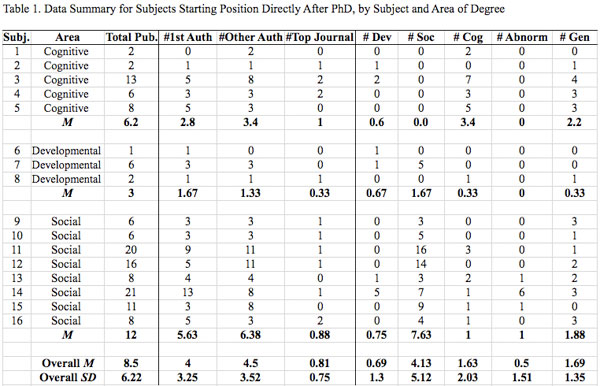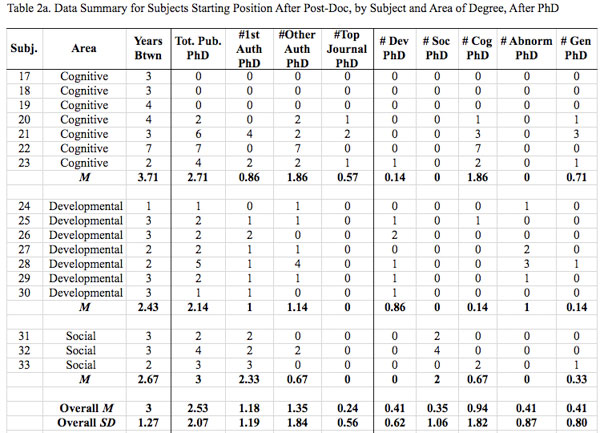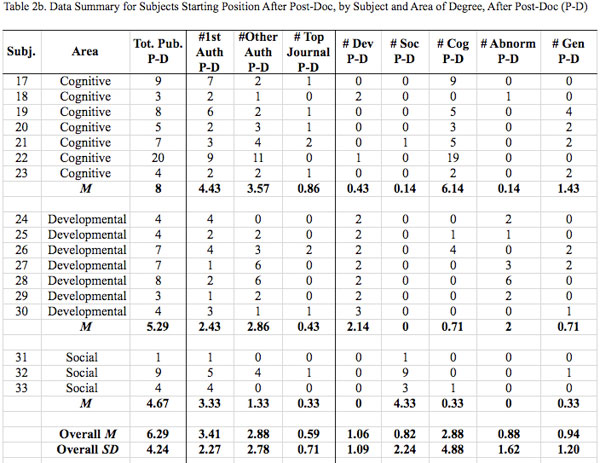Cover Story
Getting Hired
As I begin my final year of graduate school and look ahead (though not necessarily forward) to the job application process and an academic job market that is even less promising than when I began in the fall of 2006, I’m worried about the comparative length of my curriculum vita. How can I possibly compete with the hypothetical peer I’ve conjured in my imagination? By the end of her first semester, she finished her coursework and Master’s degree, and by the end of the second her dissertation research was done. Her first publication was in Science but, worried about perceptions of patriotic chauvinism, she tossed Nature a bone of a manuscript shortly thereafter. She knows exactly how and when to say “no,” but is still a little confused as to why anyone would ever need to. She meets Reviewer 3 for happy hour every Thursday night and trades hair tips with Steven Pinker. Worst of all, she’s a nice person.
Like many naive grad students I went through the early stages of my graduate education with the mistaken belief that academia would never reduce my professional worth and job prospects to the number of lines on my vita. I mean, that’d be like saying you can quantify and reduce this winning personality (and terrific smile) to, like, five dimensions. With reality now firmly in place and with varied, occasionally contradictory professional advice now coming from all directions, the scientist in me decided the best way to get a handle on my prospects would be to quantify academia before it does so to me.
Specifically, I wanted an objective idea of what sort of career paths and publication records yielded “typical” assistant professorships in recent years, as well as whether and how these vary depending on the subdiscipline. How many first-authored publications and top journal publications do these hired individuals typically have at the completion of their PhD? What proportion pursue a postdoc after grad school, and are postdocs more common in some subdisciplines than others? Do the grad school records of those who went on to a postdoc differ greatly from those hired straight out of grad school and, if so, in what ways? For those pursuing postdocs, what was achieved during these periods, and how do their grad school and postdoc records compare?
While there are obviously plenty of other, less tangible factors that figure into someone’s hiring (really, my smile is fantastic), and while in this instance there is a fine line between quantified comparisons and hollow scorekeeping, bear in mind that my goal was not to decipher an “equation” of such hires to then shoot for some quota that would guarantee a job. Rather, my goal was to get a more straightforward idea of the various timelines and productivity levels that ultimately led to respectable assistant professorships. I sought an objective perspective to complement the professional advice that often comes, somewhat ironically, in the form of anecdata. Comparing the post-PhD publication records of those who pursued postdocs to the grad school records of those hired as assistant professors right after their PhD provides a more objective and relevant idea of what sort of grad school publication records are associated with taking a few years as postdoc than, for instance, the experiences of a couple of past students from my own department who went on the job market for different specialties in a different economy.
Although the data and inferences below are based on a sample that is biased toward jobs matching my own particular interests and priorities, the nature of my research interests (which span social, cognitive, and developmental fields) along with the relatively wide range of jobs I would consider applying for (in this economy, a job, any job, looks pretty good to me), meant a large number of job ads piquing my interest. Hopefully this translates into useful bits of information, however small, no matter your background or particular academic career aspirations. (On a side note, this sample bias is also clearly only the tip of the iceberg as far as the empirical issues inherent in such a quick-and-dirty investigation, but I think it’s safe to assume that anyone reading this strictly for its scientific merit has far more pressing issues to attend to as far as their professional development.)
First, I reviewed all academic psychology employment ads posted in the APS Observer and APA Monitor between August 2006 and July 2008, a period covering approximately two academic hiring seasons (2006-2007, 2007-2008), and recorded the institutions and job start dates of all listings of interest (N = 120). I then conducted a series of internet searches of department websites in order to identify the job recipient corresponding to each listing. Only cases in which the match between job ad and hired individual was confirmed were used for further data collection (N = 65). Education, employment, and publication histories of these individuals were then gathered either in the form of a downloadable curriculum vita, or an analogous listing on a department webpage. Of the 65 individuals identified as recipients of positions of interest, these histories were available for approximately half (N =33).
From these professional histories, I recorded 1) the number of first-authored manuscripts at completion of PhD; 2) the number of other (non-first authored) manuscripts at completion of PhD; 3) the number of publications in “top” journals at completion of PhD, including Science, Nature, Proceedings of the National Academy of Sciences, Psychological Science, Psychological Review, Psychological Bulletin, American Psychologist, and Annual Review of Psychology; 4) the number of publications in developmental psychology journals; 5) the number of publications in social or personality psychology journals; 6) the number of publications in cognitive psychology journals; 7) the number of publications in abnormal, clinical, or neuropsychology journals; and 8) the number of publications in general psychology journals. Due to their relative primacy in hiring considerations, only publications in empirical journals were recorded, thus excluding encyclopedia entries, book chapters, any other non-empirical publications, and any empirical work published as part of conference proceedings. Since just over half of the 33 individuals in the final sample (N =17) were hired after completing a postdoctoral position, and due to the fact that these job candidates have slightly different expectations placed on them by potential employers, data collected on these individuals were divided between the pre-PhD period and the period between receiving a PhD and the start of their academic position. The number of years in this post-PhD period was also recorded for these individuals. (Editor’s Note: For tables showing this data, see the online posting of this article at www.psychologicalscience.org/observer.)
Keeping the assumption of sample representativeness in mind, the data seem to tell the following stories at least for these three subdisciplines. Social psychology PhDs took the fastest track to a professorship. By the time they had finished their PhD, those hired in social psych posts right after grad school had accumulated roughly 10 publications, of which one was usually in a top journal, and of which about half were first authored. Cognitive psychology PhDs hired out of grad school, by comparison, had produced about half as many publications in total, and developmental PhDs a quarter to a third as many as social PhDs by the time of degree completion. The comparatively high level of productivity among social psychology PhDs is not that surprising, given that the rate at which their experiments are run tends to be far beyond that of, for instance, longitudinal investigations by developmentalists. While these differences could be alternatively attributed to something such as comparatively greater scientific talent among social psych PhDs, this possibility is somewhat ruled out by the fact that social psych PhDs did not have a commensurately higher number of top journal publications compared to other subdisciplines. (Besides, everyone knows all the talent goes to developmental psychology.) (I’m kidding, of course….)
Of the social psychology PhDs who ended up being hired for one of the academic posts in question, only a minority held a postdoc. Most went right from degree to job. Although there is no way to be certain, postdoc positions may have been more of a “Plan B” — a premeditated reaction to a relatively sparse grad school publication record — than a first choice; this group produced about a third as many publications during their PhD years as those hired out of grad school. Their eventual hires can probably be attributed, at least in part, to postdoc periods that were, on average, as productive as their colleagues hired right out of their PhDs. Over the course of postdoc positions that were about half as long as graduate school, these postdocs produced approximately half as many publications as their post-PhD hire peers produced during graduate school. Developmental psychology PhDs in this sample, on the other hand, seemed to take the longest route to academic hire of the three subdisciplines. The majority of these individuals pursued postdocs after graduate school, but this did not seem to be a “Plan B” for them; they entered these postdoc positions with better grad school publication records than those hired out of grad school. In the postdoc period, their rate of output increased to that of their social psych peers.
Cognitive psychology PhDs were a bit more difficult to categorize as either fast track or late bloomers; those hired after grad school had, on average, about twice as many publications as those pursuing a postdoc. At the same time, the majority of cognitive PhDs completed a postdoc before being hired to an academic post, though of the three groups these individuals were also most evenly split between those pursuing postdocs and those going straight into assistant professorships after grad school. The postdoc period appears to be particularly fruitful for cognitive PhDs, as they produced almost twice as many publications, on average, as their social and developmental peers, more than half of these first authored. Maybe this is because cognitive PhDs spent about a year longer, on average, in their postdoc posts than the other two groups.
Here are some more general observations that may be of interest. First, in all three subdisciplines, and in both postdoc and non-postdoc career paths, publications were typically split 50/50 between first- and other-authored works, so those hoping to make up for a lack of original work with a large number of publications with which they had minor involvement may not be helping themselves much given the preferential hiring of those with relatively high proportions of first authorships. Second, being published in a top journal is, not surprisingly, always helpful; lacking a publication in such journals was what those pursuing postdocs across all three subdisciplines had in common most of all. (The good news is that by the time these postdocs were hired, many had at least one top publication to their name.) To be sure, a lack of top publications does not appear to be a barrier in terms of being hired in a good assistant professorship, as about half of those sampled had none by the time they were hired. Last, while a postdoc appears to be a viable option for those who may not have produced much during grad school, those hoping to land a job through this route should expect much greater productivity demands to be competitive for these jobs, to the extent that they will produce twice as much in half the time as in grad school.
The publication and career path experiences of social, cognitive, and developmental PhDs appear to differ quite a bit, though general patterns existed. Being aware some of these differences and commonalities may be helpful or at least comforting to grad students planning to enter the academic job market. Social psychology PhDs appear to be “ready for prime time” much sooner than most cognitive and developmental students, the majority having long publication lists by the time they finish grad school. Those in social psych nearing the end of graduate school may want to consider postdocs if they don’t have substantial publication records already. Second, developmental psychology PhDs appear to have lower grad school productivity on average, and (perhaps because of this) those in this sample opted to pursue postdocs more often than their peers in other fields. Interestingly, and in contradiction to the hypothesis that postdocs are for those with lackluster grad school productivity levels, there was no real distinction between grad school records of developmentalists pursuing postdocs and those going straight to professorships, so other factors may be more relevant to deciding to pursue a developmental postdoc, such as obtaining different but complementary training that might enable them to address intriguing questions that depend on such extended training. In any event, the postdoc period appeared beneficial to developmentalists, as the increases in output between grad school and the end of the postdoc period brought them up to the productivity level of their social psych peers.
Third, cognitive psychology PhDs appear to be equally likely to enter professorships as to pursue a postdoc after grad school. Whatever the reason for opting to pursue postdocs, cognitive PhDs who did so in this sample found this period more fruitful than either of the other two groups; these individuals had the greatest increases in output between grad school and the end of their postdoc. Finally, across all three disciplines, what was most clear was that a good balance between first- and other authored works is important; a top journal publication never hurts, but it’s nearly as common to be hired for an assistant professorship without one; and while a postdoc may be a viable option for those with more mediocre grad school publication records, these positions seem to pay off: Postdocs double their output, which probably isn’t due solely to the increases in resources available to them. Conversely, viewing a postdoc as a proxy for additional time in grad school may be ill-advised, as the additional time these positions afford for producing more publications before entering the job market is countered by greater publication demands compared to grad school. In other words, in terms of productivity demands, a postdoc position is not a continuation of grad school, but rather a large step up from the PhD years.
Finally, notwithstanding the tongue-in-cheek tone of parts of this essay, the question of what it takes to land a good academic position is one that is obsessed over by graduate students. It would be enormously beneficial to the field to gather more systematic data than I was able to do with this sample of only 33 job candidates, in order to inform and guide graduate students on career decisions. We spend considerably more time compiling statistics of far less importance; my hope in describing this little survey is to encourage others to tackle it on a grander level. 






Comments
This article is GENIUS! Thank you so much for this. As someone preparing to enter a social psychology PhD program, this gives me a great goal to strive for. I may have to try this analysis with updated 2008-2010 numbers…
One question: why did you choose those particular journals as ‘top’ journals? For example, the Journal of Personality and Social Psychology has an impact factor has an impact factor of 4.877 and is excluded, while Psychological Science has an impact factor of 4.543 and is included.
APS regularly opens certain online articles for discussion on our website. Effective February 2021, you must be a logged-in APS member to post comments. By posting a comment, you agree to our Community Guidelines and the display of your profile information, including your name and affiliation. Any opinions, findings, conclusions, or recommendations present in article comments are those of the writers and do not necessarily reflect the views of APS or the article’s author. For more information, please see our Community Guidelines.
Please login with your APS account to comment.